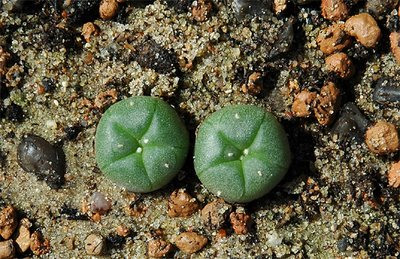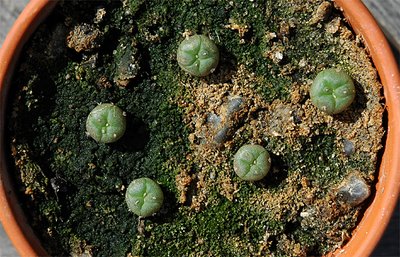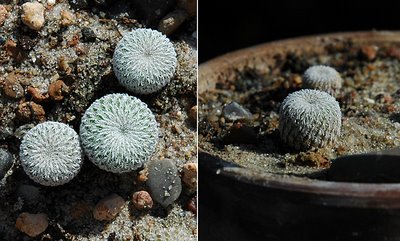According to common belief, species from Lophophora, Epithelantha, Ariocarpus etc, do not like subfreezing temperatures. This is not entirely true - many varieties will survive temperatures dropping well below freezing. The last couple of years I've experimented with growing Lophophora, Epithelantha, and Acharagma in an unheated greenhouse, and this winter the plants had to endure temperatures below -10C (14F) for extended periods. I'm planning on growing Ariocarpus as well if I can find seeds originating from the Trans-Pecos area.
Lophophora
Lophophora williamsii – started from seed 2004
The picture above shows Lophophora williamsii (SB 854; Starr Co, Texas) plants sown May 1, 2004. After 2 years in the coldhouse the plants are thriving - more plants have been disfigured and killed by bush-crickets and other critters than by the cold. The remaining 5 plants are each 1.5 cm (~ 0.6'') wide.
Lophophora williamsii – started from seed 2005
Last years batch of Lophophora williamsii (SB 854; Starr Co, Texas) seedlings are also doing well. The 5 plants have obtained a diameter of 1 cm (~ 0.4'').
The more southern living Lophophora diffusa is not handling the cold as well - none of the plants started from seed in 2004 are left, and only 2 plants from the 2005 crop are still surviving. The L. diffusa seeds originated from plants from Higuerillas, Queretaro. The 11 Lophophora decipiens seedlings from last year are doing slightly better, but as the L. diffusa seedlings they have only grown to a width of 0.5 cm (~0.2'').
Epithelantha
Left: E. micromeris v. greggii (Cuesta la Muralla, Coahuila)
Right: E. micromeris (SB 1327, near Belen, New Mexico)
I'm growing Epithelantha micromeris v. greggii (Cuesta la Muralla, Coahuila) and Epithelantha micromeris (SB 1327, near Belen, New Mexico). The New Mexico variety is a slow grower – the 12 plants are less than 1 cm (~ 0.4'') wide – but it is handling the cold very well. The Coahuila variety is growing faster but is more susceptible to frost damage – the 11 plants are each 1.5 cm (~ 0.6'') wide. All plants were sown May 1, 2004.
Acharagma
The Acharagma aguirreana (RSM 396; Sierra Paila, Coahuila) and Acharagma roseana (LX 578; Ramon Arizpe, Coahuila) seedlings from last year are still fairly small – less than 0.5 cm (~0.2'') in width. A. roseana seems to be better at tolerating frost than A. aguirreana; I sowed 30 seeds of each species, and 20some seedlings of each germinated. Today more than 20 A. roseana are surviving while only 3 A. aguirreana are left.
Malpighia 1927 v.30 (added: 11/24/2025)
-
*By:*
Borzi, Antonino,1852-1921.
Penzig, O.1856-1929.
Pirotta, Romualdo,1853-1936.
*Publication Info:*
Messina : g. Capra & co., 1887-89 ; Genova : Tip. di A...
5 weeks ago



















Hi, interesting results. The Epithelantha micromeris SB 1327 should be very cold hardy indeed. I've had it down to below 5F for several nights in a row when I lived in Santa Fe, NM. (dry and acclimated to winter by being outside but under cover). We were growing several of these outside in full exposure in the holes in Tufa volcanic rock with 100% survival as well, including months under snow cover.
ReplyDeletepeter breslin
Tempe AZ
Thanks Peter, that's very good information. Temperatures of 5F (-15 degrees Celsius) are very rare in the area where I grow these plants, so I guess I can stop worrying about the Epithelantha micromeris SB 1327 making it through winter ;-)
ReplyDeleteIm getting some shiped , I dont have to worry bout em frrrzing with this info
ReplyDeleteProbably not :-) Different varieties show different levels of cold hardiness but most will survive the cold if properly acclimatized.
Delete